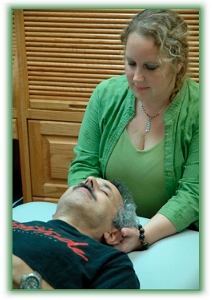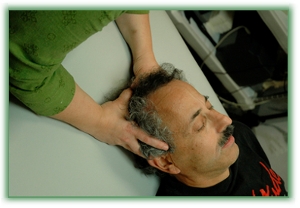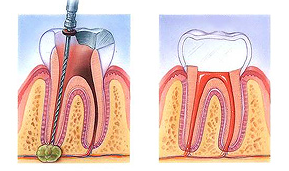Specialty Services in Durango, CO
Why race across town to dentists you don’t know? We provide comprehensive, specialized dental care in one familiar place.
At Dr. Rothchild’s dental practice, east meets west. For an integrative approach to your treatment, we may use acupuncture as an adjunct to mild sedation, dental anesthesia, pain control, and TMJ pain.
Another alternative therapy and optional adjunct is MPS Therapy (Microcurrent Point Stimulation). This therapy integrates acupuncture, microcurrent therapy, cranial osteopathic techniques, intramuscular stimulation, trigger point treatment, and neural therapy.

What is Cranial Osteopathy?
Osteopathic health care is the philosophy that the body has mechanisms and substances that, if given the opportunity, will establish balance and recreate health. Restrictions to the harmonious functioning of these processes can cause disease. By relieving these restrictions to proper motion, the body has the ability to restore harmonious function.
Osteopathic physicians and dentists are skilled in the use of their hands to diagnose and treat dysfunctions of the body. Manipulation of bones, soft tissues and fluids stimulate the body’s self-healing mechanisms to aid in the recovery or prevention of disease processes and to relieve pain.
How can it help you?
Techniques of Cranial Osteopathy are used whenever structural problems have a negative impact on health. Patients of all ages can be treated successfully.
Adults who have experienced serious medical problems or who have a history of severe injuries may not respond as well to treatment as a child or someone with less serious problems. It is important to remember that the younger the patient, the more resilient the tissues. Recent injuries respond more easily than those that are long standing. Patients must be evaluated individually because each patient is unique and will respond differently.

Physicians and dentists performing Cranial Osteopathy use gentle techniques, but some discomfort may occur when the therapy is focusing on a particular area of restriction. The discomfort will often subside as the treatment progresses.
Dr. Rothchild is one of only a few dentists in the country who prescribes, treats, and teaches this concept. As a member and former board member of the Cranial Academy, he continues to upgrade the skills and knowledge necessary to provide the finest care in the field of Cranial Osteopathy.
Pinhole Gum Rejuvenation™
A Breakthrough Treatment For Gum Recession
Gum recession is the process in which the margin of the gum tissue that surrounds the teeth wears away, or pulls back, exposing more of the tooth, or the tooth’s root. The progression of gum recession can eventually weaken your teeth, causing greater sensitivity, root damage and even tooth loss.
Gum Recession can result from several factors, including;
• Misaligned bite
• A genetic inclination toward gum recession
• Clenching or grinding
• Hormonal fluctuations
• Improper brushing
• Inadequate dental care over an extended period of time
• Periodontal disease
• Piercings of the lips, tongue, or gums
• Crooked teeth
Advantages of Pinhole Surgical Techniques ™ (PST™)
• No incisions or sutures
• No need for scalpels or invasive surgical tools
• No need to take donor tissue from the patient’s palate
• Fast recovery and healing time
• Multiple teeth can be treated in one visit
• Excellent, natural-looking, long-lasting results
Treat your Recession today!
If you are concerned about receding gums and want to explore alternatives to a gum grafting procedure, please call us today! We will be happy to discuss the details and benefits of The Pinhole Surgical Technique™.
Hospital Dentistry is a service that we can provide for patients that are severely medically compromised or apprehensive or uncontrollable children. This includes children that may have a significant amount of work that needs to be done and special needs children. Mercy Regional Medical Center provides board certified and licensed anesthesiologists that provide the service in the operating room setting. Side effects typically associated with hospital anesthesia are virtually nonexistent.
Mercy Regional provides the billing and fees for the service independent of Dr. Rothchild’s fees.
In the past, if you had a tooth with a diseased nerve, you’d probably lose that tooth. Now, with “root canal therapy,” your tooth can be saved. When a tooth is cracked or has a deep cavity, bacteria can enter the pulp tissue and germs can cause an infection inside the tooth. If left untreated, an abscess may form. If the infected tissue is not removed, pain and swelling can result. This can injure your jawbones and be harmful to your overall health.
Root canal therapy involves one to three visits. During treatment, your general dentist or endodontist removes the affected tissue. Next, the interior of the tooth will be cleaned and sealed. Finally, the tooth is filled with a dental composite. If your tooth has extensive decay, your dentist may suggest placing a crown to strengthen and protect the tooth from breaking. As long as you continue to care for your teeth and gums with regular brushing, flossing, and checkups, your restored tooth can last a lifetime.
Root canal therapy may not be for everyone. There are times when health is a concern that root canal therapy may not be appropriate and removal of the infected tooth is preferred.
Tooth decay can progress down into the pulp. When this happens, the pulp can become infected. Infection of the pulp can be very painful and can also deteriorate into an abscessed tooth when infection and swelling develops in the tissues around or beneath the tooth. When the pulp becomes infected or the tooth becomes abscessed, it is necessary to perform a root canal.

Why do I feel pain?
When the pulp becomes infected due to a deep cavity or fracture, bacteria can seep in. When there has been an injury due to trauma, the pulp can die. Damaged or dead pulp causes increased blood flow, pressure, and cellular activity. Pain in the tooth is commonly felt when biting down or chewing, and eating or drinking hot and/or cold foods and beverages.
Why do I need root canal therapy?
The tooth will not heal by itself. Without treatment, the infection will spread. The bone around the tooth will begin to degenerate, and the tooth may fall out. Pain usually worsens until one is forced to seek emergency dental attention. The only alternative is extraction of the tooth, which can cause the surrounding teeth to shift, resulting in a bad bite. Though an extraction is cheaper, the space left behind will require an implant or a bridge, which can be more expensive than root canal therapy. If you have the choice, it’s always best to keep your original teeth.
What are the risks and complications with root canal therapy?
More than 95 percent of root canal therapies are successful. However, sometimes a case needs to be redone due to diseased canal offshoots that went undetected, or the fracturing of the canal filling. More commonly, a root canal therapy will fail altogether, marked by the return of pain.
What happens after root canal therapy?
Once the root canal therapy is completed, a permanent filling or crown will be needed to protect the tooth from fracture (the structure of the tooth is compromised) or reinfection. A crown will be necessary… …in some cases. Our team will determine the best choice for your individual needs.
How long will the restored tooth last?
Your restored tooth could last a lifetime, if you continue to care for your teeth and gums. However, regular checkups are necessary. As long as the root(s) of a treated tooth are nourished by the tissues around it, your tooth will remain healthy.
How does root canal therapy save my tooth?
- An opening is made through the crown of the tooth into the pulp chamber.
- The pulp is removed, and the root canals are cleaned, enlarged and shaped.
- Medications may be put in the pulp chamber and root canal(s) to help get rid of germs and prevent infection.
- A temporary filling will be placed in the crown opening to protect the tooth between dental visits. Your dentist may leave the tooth open for a few days to drain. You might also be given medicine to help control infection that may have spread beyond the tooth.
- The temporary filling is removed and the pulp chamber and root canal(s) are cleaned and filled.
- In the final step, a gold or porcelain crown is usually placed over the tooth.
If you or a family member chronically snores and wakes up extremely tired in the morning, it is possible that they or you are dealing with a sleep disorder known as Sleep Apnea.
Sleep Apnea occurs when a section of the airway becomes obstructed, causing the body to essentially choke on itself. This obstruction can cause repeated episodes of partial or complete suffocation, sometimes lasting a minute or more while the sufferer is asleep. Because these choking and suffocating episodes can often repeat frequently throughout the night, they can put the sufferer at increased risk of a myriad of health complications including stroke, heart attack and even death. Amazingly, nearly 1 in 4 adults over 30 are suffering from at least a mild degree of Sleep Apnea and don’t even know it.

The cause of this collapse in the airway is typically due to the soft tissues in the mouth, tongue or throat closing and blocking airflow during sleep. The first sign of this is often snoring, which occurs when one is attempting to breathe through a narrow airway. If left untreated, snoring frequently escalates to full OSA (Obstructive Sleep Apnea), caused when the narrow airway has become completely blocked.
Are you at risk?
There are several risk factors and symptoms which may indicate OSA. Ask yourself the following questions:
- Do you snore loudly (louder than a person talking or loud enough to be heard through closed
- doors)?
- Do you often feel tired, fatigued or sleepy during the day?
- Has your spouse or bed partner ever observed you stop or pause breathing in your sleep?
- Do you have or are you being treated for high blood pressure?
- Are you overweight or obese?
- Are you over 50 years old?
- Is your neck circumference greater than 16 inches?
- Are you male?
If you answered yes to two or more of the above questions, it makes sense to have your sleep health evaluated. Our practice offers sleep assessments if you feel that you are possibly dealing with OSA.
New Hope for Sleep Apnea treatment with Oral Appliances
Traditionally, OSA has been treated with a CPAP machine, which feeds oxygen from an O2 tank into tubes that must be attached under or around the nose and sometimes even the mouth at night. While this helps to supply more oxygen to the CPAP patient, CPAP machines can be uncomfortable and noisy, which can makes compliance for some patients challenging.
Our practice specializes in fitting OSA patients with a custom fabricated oral appliance to help minimize the obstruction which often causes sleep apnea. The appliance works by holding your mandible (lower jaw) in a precise open and forward position. By doing so, the soft tissues in the throat and neck are no longer in a position to collapse, the typical cause of the nighttime choking and suffocating episodes associated with OSA.
The oral appliances that we make at our practice to treat Sleep Apnea are custom fitted for each patient over the teeth and are worn much like a sports mouthguard. This low-impact appliance is usually much easier for OSA sufferers who find CPAP therapy difficult to tolerate, also resulting in more effective treatment for the patient. In 2015, the American Academy of Sleep Medicine issued updated treatment parameters, additionally recommending the use of custom fabricated oral appliances by specifically trained dentists for patients with snoring and sleep apnea who prefer the mouthpiece over CPAP therapy, or who have tried CPAP and are unable to maintain daily use.
Oral appliances can be a very comfortable and easy to use solution for managing Sleep Apnea and chronic snoring. If you currently have been diagnosed with Sleep Apnea or suspect that you may have it and would prefer to not use a CPAP machine, consult our office for a sleep assessment and to determine if you are a good candidate for a custom fitted oral appliance.
Get the rest you need!
Watch video below for more information on Sleep Apnea.
Dr. Rothchild has been involved in the treatment of TMJ and craniofacial pain for over 30 years. He is a member of several professional organizations that specialize in the field of pain management and head and neck pain. He has lectured on the subject throughout the United States and internationally. His approach to treatment is based on the individual. Every patient is unique and has different problems structurally that may be contributing to the problem.
The outcomes of his work have been highly successful throughout the years. The approach he takes initially is a very conservative approach.